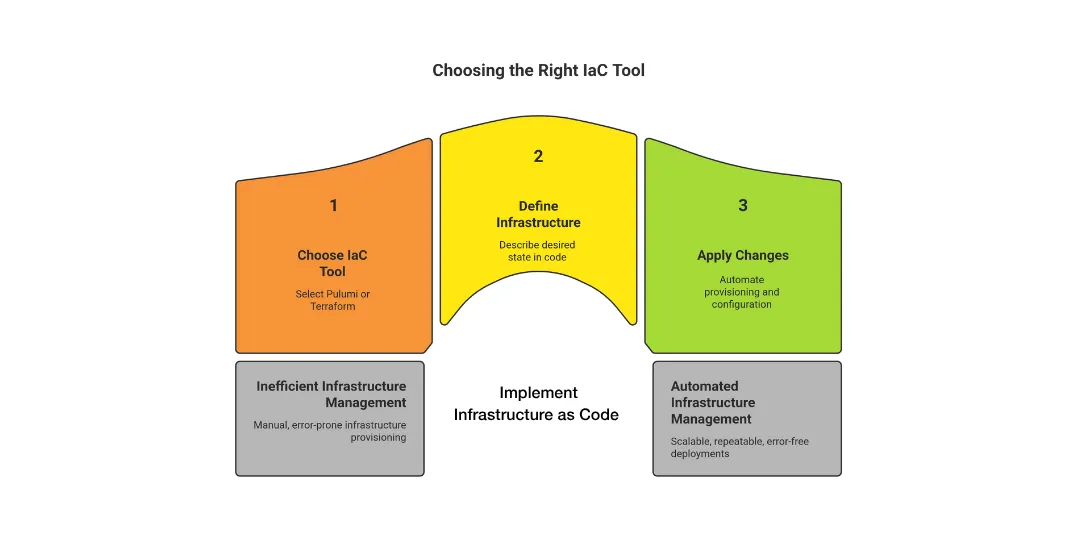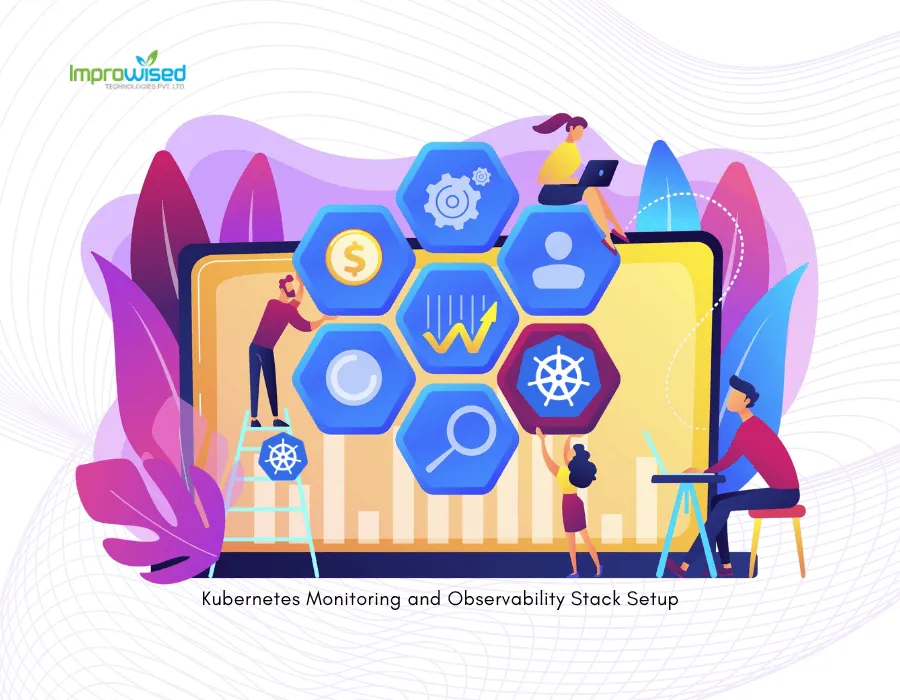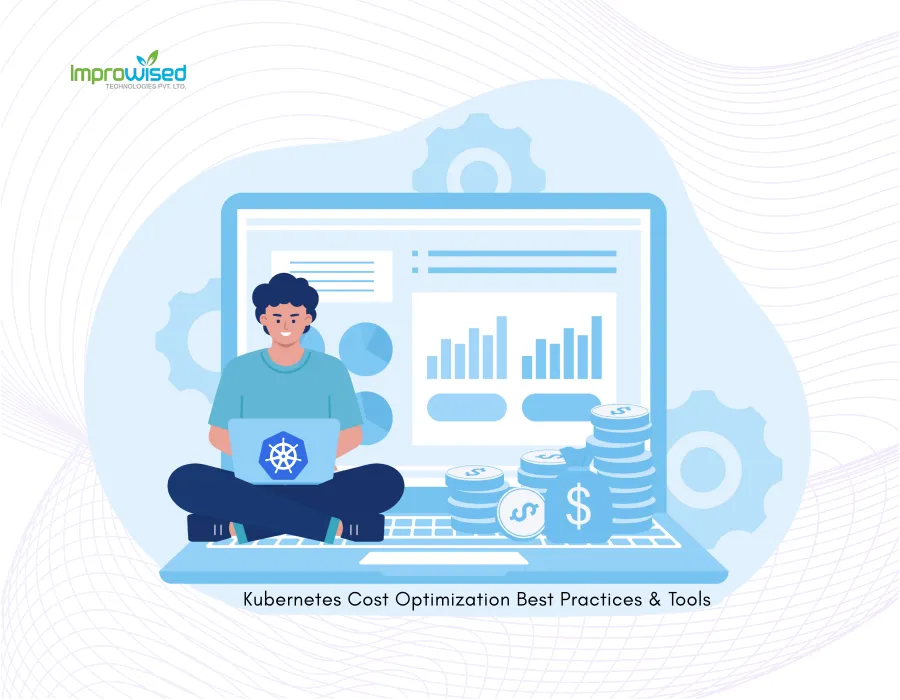November 3, 2025
Pulumi vs Terraform: How to Choose the Best Programming Language IaC Tool Today

By Shyam Kapdi
Improwised Technologies Pvt. Ltd.
Infrastructure as Code (IaC) has revolutionized modern cloud operations and DevOps practices, enabling teams to provision, configure, and manage infrastructure through code rather than manual processes. This automation accelerates deployments, minimizes human errors, and offers repeatability and scalability crucial to agile businesses.
Pulumi and Terraform stand out as leading IaC tools, each representing different paradigms and design philosophies. Choosing the right IaC tool and specifically the programming language underpinning it is critical because it shapes developer productivity, code quality, and long-term maintainability.

Terraform vs Pulumi: They are two leading Infrastructure as Code (IaC) tools designed to automate cloud infrastructure management, but they have distinct approaches, strengths, and ideal use cases that influence when to choose one over the other.
Also Read: OpenTofu vs Terraform: The Complete Guide for Infrastructure Teams
Understanding IaC Programming Paradigms
What is Terraform?
Terraform is an open-source Infrastructure as Code (IaC) tool created by HashiCorp that lets users define, provision, and manage cloud and on-premises infrastructure using human-readable configuration files called HashiCorp Configuration Language (HCL).
How Terraform Works
Terraform uses a declarative approach. You describe your desired infrastructure state in code, and Terraform calculates and applies the changes needed to achieve that state. This process supports a consistent workflow for provisioning, updating, and versioning infrastructure components like virtual machines, networks, databases, and more.
Key Components of Terraform
- Configuration Files: Written in HCL, these files declare resources, input/output variables, and modules for infrastructure management.
- Providers: Plugins that allow Terraform to manage resources across different cloud platforms (AWS, Azure, GCP), on-premises solutions, and SaaS tools by interacting with their APIs.
- State File: Terraform stores information about current infrastructure in a state file to accurately track changes and ensure resources match the desired state.
- Execution Plan: Before any changes are applied, Terraform generates a plan showing what will change. Users approve this plan for predictable, controlled deployments.
- Modules: Reusable infrastructure units defined in separate blocks to organize and share code, enabling scalable and maintainable environments.
What is Pulumi?
Pulumi is a modern Infrastructure as Code (IaC) platform that enables developers and DevOps teams to define, deploy, and manage cloud infrastructure using familiar programming languages such as JavaScript, TypeScript, Python, Go, .NET, and Java.
How Pulumi works Unlike traditional IaC tools that rely on domain-specific languages (DSLs) like HCL or YAML, Pulumi leverages the power of full-fledged programming languages to allow complex logic, abstractions, and code reuse, which makes managing infrastructure more flexible and intuitive.
Key Components of Pulumi
- Language SDKs: Facilitate managing cloud resources using languages developers already know and use daily, supporting over 150 providers, including AWS, Azure, and Google Cloud.
- CLI (Command-Line Interface): The main tool for deploying, updating, or destroying infrastructure from local machines, and integrating with CI/CD pipelines.
- Deployment Engine: Interprets the code, calculates the desired resource state, and interacts with cloud provider APIs to make the necessary changes, tracking the current and desired states.
- Pulumi Stacks: Manage different environments such as development, staging, and production, each with its own configuration and state.
Why use Terraform
- Large-scale infrastructure provisioning with complex dependencies.
- Environments requiring mature and stable IaC with extensive provider support.
- Teams adopting a declarative approach and separate infrastructure code from application logic.
- Organizations with established workflows around HCL and Terraform Cloud.
- Multi-cloud infrastructure deployments need wide provider coverage.
Why use Pulumi
- Development teams prefer to use familiar programming languages.
- Infrastructure automation requires custom logic, loops, or advanced programming constructs.
- Scenarios requiring faster iteration and integration with existing app development tools.
- Infrastructure is combined tightly with application code as part of DevOps pipelines.
- The Pulumi service supports teams requiring advanced policy enforcement and collaboration features.
Similarities Between Terraform and Pulumi
- Both tools automate cloud infrastructure provisioning and management.
- Support multiple cloud providers with plugins/providers.
- Maintain resource state for lifecycle management.
- Enable infrastructure versioning, collaboration, and environment consistency.
- Facilitate importing existing infrastructure into code.
Side-by-Side Comparison of Pulumi vs Terraform
| Feature | Pulumi | Terraform |
|---|---|---|
| Language Support | Python, TypeScript, Go, C#, Java | HashiCorp Configuration Language (HCL) |
| Programming Paradigm | Imperative with full programming language functionality | Declarative, domain-specific language |
| State Management | Cloud service or self-managed, encrypted secrets handling | Local or remote state files, manual concurrency handling |
| Testing & Validation | Unit and integration tests in native languages | Basic validation, external tools (e.g., Terratest) |
| Developer Tooling | Full IDE support, debugging, and linting | Good extension support in popular editors |
| Ecosystem Maturity | Growing rapidly with multi-language providers | Large, mature, broad community and modules |
| Security & Compliance | Policy as Code via Pulumi Policy Framework | Sentinel for policy enforcement, Vault integration for secrets |
| Licensing & Cost | Open source core, commercial SaaS tiers | Open source core; Enterprise and Cloud tiers are commercial |
| Performance & Scalability | Scales well with complex logic and programming constructs | Proven at large scale, robust multicloud deployments |
| Multi-cloud & Hybrid Cloud | Supports multiple clouds in one language context | Extensive provider ecosystem for hybrid environments |
| CI/CD & DevOps Integration | Strong automation API, integrates with GitHub Actions, Jenkins | Deep integration with CI/CD tools and workflows |
| Learning Curve & Resources | Steeper if new to languages; developer-friendly for programmers | Easier for ops teams; rich community tutorials and modules |
Also Read: Modular Infrastructure Design: Promoting Reuse and Maintainability in IaC
Real-world Use Cases and Decision Factors
Choose Pulumi if:
- Your teams are developer-centric, proficient in programming languages like Python or Go.
- You need to embed infrastructure logic tightly with application code or complex workflows.
- Kubernetes-heavy environments where native APIs and testing infrastructure are critical.
- You want rapid innovation and flexibility with dynamic provider support.
- At Improwised Technologies, Pulumi is preferred for projects involving sophisticated Kubernetes clusters and cloud-native automation with custom logic.
Choose Terraform if:
- Stability, a large community, extensive provider support, and enterprise governance are priorities.
- You operate in various multi-cloud or hybrid environments requiring battle-tested IaC.
- Your team favors declarative configuration and has deep DevOps and infrastructure experience.
- Terraform’s mature modules accelerate bootstrapping infrastructure.
- Improwised Technologies leverages Terraform for large-scale multi-cloud provisioning projects where consistent, predictable infrastructure management and compliance matter most.
Ecosystem and Community Insights
- Terraform’s ecosystem is broader with more mature modules and extensive community support.
- Pulumi’s community is growing fast with rich language-specific tooling and direct cloud API integrations.
- Both provide official documentation, training, and commercial support, but Pulumi’s developer-centric model encourages more programmatic experimentation.
Security, Compliance, and Governance
- Both tools focus on policy as code for governance, with Terraform and Pulumi Policy as Code frameworks.
- Secret management is baked in for Pulumi with encryption and KMS support; Terraform integrates well with Vault but requires more setup.
- Compliance attachment and audit trails are supported in both, with Terraform Enterprise strongly catering to enterprise regulatory needs.
Integration with DevOps and CI/CD Pipelines
- Pulumi offers an Automation API that facilitates embedding IaC in CI/CD pipelines natively, enhancing control and programmability.
- Terraform integrates seamlessly with popular CI/CD tools like GitHub Actions, Jenkins, GitLab CI, and Azure DevOps; Terraform Cloud enhances workflow automation.
- Both tools enable automated infrastructure lifecycle management, enabling continuous delivery of infrastructure changes aligned with application deployments.
Also Read: How to Reduce AWS Costs: Best Practices and Optimization Tools
Conclusion
Choosing between Pulumi and Terraform goes beyond features-it’s about aligning the IaC tool with your team’s skills, infrastructure complexity, and DevOps maturity. Pulumi excels as a developer-friendly, flexible tool for those comfortable with coding and looking for advanced infrastructure programmability. Terraform remains the stalwart of declarative IaC with unmatched ecosystem maturity and enterprise readiness. For expert guidance tailored to your company’s unique infrastructure needs and to help you make the right choice with seamless implementation, connect with Improwised Technologies - your trusted partner in delivering customized infrastructure and code solutions with deep expertise in both Pulumi and Terraform.
Frequently Asked Question
Get quick answers to common queries. Explore our FAQs for helpful insights and solutions.

October 31, 2025
Kubernetes Monitoring and Observability Stack Setup: Best Tools and Cost Monitoring

By Improwised Editorial Team
Improwised Technologies
Pvt. Ltd.

October 29, 2025
Top AI App Development Platforms in 2025: How AI Is Transforming the Way Apps Are Built

By Shyam Kapdi
Improwised Technologies
Pvt. Ltd.


By Improwised Editorial Team
Improwised Technologies
Pvt. Ltd.
Optimize Your Cloud. Cut Costs. Accelerate Performance.
Struggling with slow deployments and rising cloud costs?
Our tailored platform engineering solutions enhance efficiency, boost speed, and reduce expenses.
